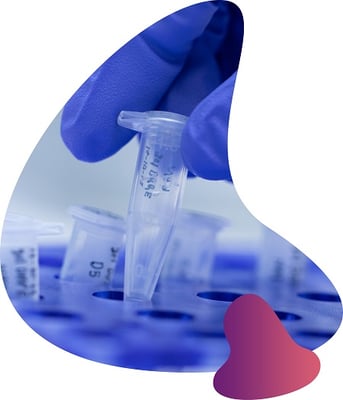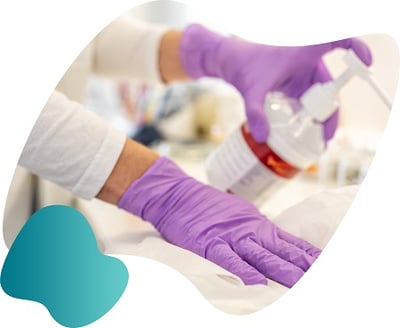Originally published : Fri, December 1, 2023 @ 4:26 PM
- False test results leading to delays, inappropriate treatment choices or undue patient stress.
- Wasted resources spent on retesting and identifying contamination sources.
- Reduced confidence in testing methods.
Controlling for contamination in qPCR assay development
- Ensure that assay components do not generate a signal in the absence of the target sequence (from dimerisation of primer or probe and subsequent amplification, or contamination of reaction components such as enzymes or buffers);
- Verify that the design is functional and specific. For example, assays for pathogen detection need to distinguish the target sequence from any similar sequences (e.g. SARS-CoV-2 assays do not detect the common cold coronavirus template);
- Assess assay efficiency and the limits of quantification and detection to ensure adequate sensitivity.
| Control | Expected result | Result | Interpretation | Action |
|
No template control
|
Negative | Negative | No contamination or primer dimers evident | • Ensure positive control is correct. |
| Negative | Positive | Primer dimers or contamination evident |
• Check assay with an intercalating dye and compare product sizes using melt curve analysis. | |
|
Target template*
|
Positive | Positive | Assay functioning | • Ensure negative control is correct. Optimisation may still be required. |
| Positive | Negative | Failed reaction | • Repeat using intercalating dye to determine whether primers, probe or both have failed. • Repeat assay using a different template to identify alternative explanations for reaction failure. |
|
|
No reverse transcription
|
Negative | Negative | No DNA amplification | • Ensure positive control is positive and NTC is negative. |
| Negative | Positive | DNA amplification (or primer dimers) |
• Read in conjunction with NTC. Both samples being positive indicates primer dimers; negative NTC and positive minus RT indicates detection of contaminating DNA. • Redesign assay to span exon junctions, or repeat RNA extraction. |
|
|
Target template serial dilution to single copies of target/minimum three replicates
|
Estimate of assay efficiency and reproducibility |
Efficiency (95–105%) Replicates highly reproducible |
Assay optimised | • Validate in conjunction with negative controls. |
| Estimate of assay efficiency and reproducibility |
Efficiency <95% or >105% Replicates highly variable |
Assay improvements required (where possible) |
• Optimise assay conditions (oligo concentrations and/or annealing temperature). • Redesign assay |
|
| Nonspecific template control (SPUD) [Internal positive control]
|
Positive (of specified Cq) |
Negative or higher Cq than expected |
Presence of contaminants inhibiting reaction efficiency |
• Systematically explore the source of contamination. May occur at any stage from sample preparation to test set-up. |
| *Validation using control template material provides additional information around assay efficiency and limit of detection. Bustin et al.2, described an exemplary study for the development of a clinical diagnostic assay. They developed a multiplex qRT-PCR for detection of SARS-CoV-2 from clinical samples and included controls for both development and inclusion of quality control assessments when applied to patient material. The negative control was a simple “No Template Control” containing all assay components, with the exception of template. This was run when assays were being validated and when combined in multiplex. The assay description clearly states that no product was amplified in the absence of a template, neither for single nor multiplex assays. This confirmed that the primers of all assays did not interact and that specific template had not found its way into the reaction components. |
Once the assay has been developed, optimised and verified, laboratory technicians run positive and negative controls with each clinical sample plate to ensure reliable diagnostic results.
Contamination sources
 Contaminated assay components
Contaminated assay components | Contamination | Source | Result | Action |
| Positive sample to negative sample |
Cross-contamination during sample handling |
False positive | • May not be detected, indicated if negative control is also contaminated. |
|
Inhibitory materials
|
Carried over during sample preparation | False negative | • Detected by multiplexed Internal or Full Process Control, or separate positive control (for example, SPUD) of known Cq/concentration. Each sample must be checked. Repeat sample processing when inhibitors are evident. |
| Contaminated reagents | All reactions delayed (lower Cq than expected) |
• Verify Cq of positive control is correct for quantity. • Replace reagents. • Consider inhibition-resistant reagents |
|
| Specific template material | PCR product leakage from previous reactions |
False positive | • If identified as such, implement a deep cleaning regimen and ensure reactions are free from contaminants before proceeding |
| Synthetic oligonucleotides (used as positive controls) |
False positive | • It is difficult to remove template contamination from such highly concentrated source material and may be necessary to redesign and optimise a new assay. Some labs have had to resort to new physical spaces. | |
| Artificial control material | False positive | • It is difficult to remove template contamination from such highly concentrated source material and may be necessary to redesign and optimise a new assay. Some labs have had to resort to new physical spaces. | |
| Human DNA/RNA | End-use contamination | Potential false positive if the assay targets human sequences |
• Use new batches of reagent. |
| Contamination of buffers occurring during manufacture |
Potential false positive if the assay targets human sequences |
• Supplier must investigate and ensure reagents free from contaminants are provided. | |
| Bacterial DNA/RNA | Contamination of buffers occurring during manufacture | Potential false positive if the assay targets bacterial sequences |
• A well-recognised challenge since many enzymes are produced in bacterial systems. Specifically manufactured reagents may be required. |
Reducing contamination risks for qPCR assays
 Laboratories may also incorporate pre- and post-amplification sterilisation techniques to reduce carryover contamination concerns. For example, when the same assay is repeated many times, using master mixes containing dUTP incorporates Uracil into subsequent PCR amplicons. Including a pre-PCR step of digestion by uracil N-glycosylase (UNG) or uracil DNA glycosylase (UDG) degrades potentially contaminating templates created by previous PCR amplification. Therefore, adding a master mix containing these enzymes to a reaction tube with target specimens allows for the hydrolysation and removal of potential contaminating amplification products before the next qPCR reaction.3
Laboratories may also incorporate pre- and post-amplification sterilisation techniques to reduce carryover contamination concerns. For example, when the same assay is repeated many times, using master mixes containing dUTP incorporates Uracil into subsequent PCR amplicons. Including a pre-PCR step of digestion by uracil N-glycosylase (UNG) or uracil DNA glycosylase (UDG) degrades potentially contaminating templates created by previous PCR amplification. Therefore, adding a master mix containing these enzymes to a reaction tube with target specimens allows for the hydrolysation and removal of potential contaminating amplification products before the next qPCR reaction.3 | Method | Mode of action | Advantages | Disadvantages |
| UV light | Thymidine dimmer | Inexpensive, requires no change in PCR protocol. | Ineffective against G+C-rich and short (>300 bp) amplification products. |
| UNG* | Enzymatic hydrolysis of the aerosolized amplicons. | Easy to incorporate, most active against T-rich amplicons. | Expensive, may reduce amplification efficiency. |
| Hydroxylamine | Chemically modifies C and prevents C+G pairing. | Inexpensive, effective on short and G+C-rich amplicons. | Carcinogenic, may interfere with amplicon analysis. |
| Isopsoralen (IP) | Modifies target by cyclobutane adduct. | Relatively inexpensive, requires minor modification of the PCR protocol. | Carcinogenic, inhibitory effect on PCR not very effective for controlling G+C-rich and short amplicons, requires added equipment. |
| Psoralen | Same as IP | same as IP | May interfere with amplicon analysis. |
| Primer hydrolysis | Post PCR hydrolysis of RNA residues of the amplicons by NaOH. | Equally effective on G+C-rich amplicons. | Variable efficacy, may generate aerosol during NaOH addition. |
*Uracial-N-glycosylase
Other methods of pre- and post-amplification sterilisation include UV light irradiation of preparation spaces and equipment, nucleic acid inactivation with furocoumarins, primer hydrolysis and addition of hydroxylamine hydrochloride to PCR reaction tubes after amplification.3


